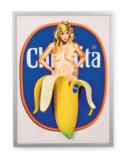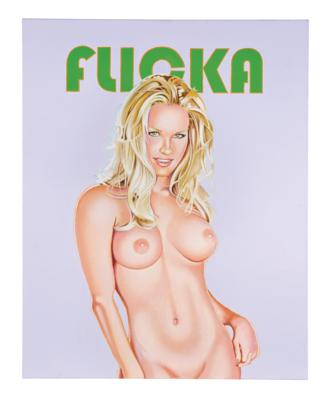Mel Ramos
(Sacramento/California 1935–2018 Oakland/California)
Flicka, 2011, signed, dated on the reverse Mel Ramos 11,
oil on canvas, 92 x 73 cm, framed
Provenance:
Galerie Burkhard Eikelmann, Düsseldorf (stamp)
Artimedes AG, Liechtenstein (stamp)
Galerie Flügel-Roncak, Nurnberg (stamp)
Private Collection North Rhine-Westphalia
Literature:
Thomas, Levy (ed.), Mel Ramos - catalogue raisonné der Bilder 1953–2015, Bielefeld 2016, p. 133 (full-page colour ill.), cat. no. 11–7, p. 268
The major theme in Ramos‘ (born 1935 in Sacramento, California) oeuvre is the idealised female nude, whether in a bed of fruit seen through a keyhole, posing with giant consumer items, playing with exotic animals or in the form of popular nude models drawn from the rich well of art history.
His works thus condense the gaze socially conditioned by visual mass media though playful interaction with popular products, comic figures or well-known actresses. The present image of the Swedish Flicka, (Girl in English), is part of a series of international female nudes drawn from the waist up who self-confidently flirt with their viewers.
Ramos brings the figures out of the anonymity of unreachable distance and gives these placeholders of collective fantasies a personal dimension. Through his simultaneously sensual and precise painting, the figures convey plump liveliness without detracting from the absurdity and artificiality of the construction they embody. The double coding of Ramos‘ nude paintings, in which past, present and future intertwine, refers and simultaneously abolishes the difference between art and life.
„Eroticism? I‘ve heard that term a lot, but I don‘t think my paintings are about eroticism, or that the paintings are erotic. I don‘t think they are that one-dimensional. Rather, I think they reflect a broader social phenomenon that is perpetuated and constantly fed. The paintings merely bring this social condition into focus, neither confirming nor denying it.“
(Mel Ramos, in: Talking with Mel Ramos, California, Dec. 1979, quoted in: Carl Belz, Mel Ramos - A twenty Year Survey, exh. cat.: Rose Art Museum, Brandeis University, Waltham, Massachusetts, 1980, Waltham, Mass. 1980, p. 20).
Ramos demonstrates that we always perceive the world and reality through the filter of media representation. His images, fed by social perspectives, direct our gaze to this. But instead of endowing his work with cynical-critical sharpness or glaring emptiness, Ramos tends to lend them an ironic-sympathetic wink.
Esperta: Dr. Petra Maria Schäpers
 Dr. Petra Maria Schäpers
Dr. Petra Maria Schäpers
+49 211 2107747
petra.schaepers@dorotheum.de
29.11.2023 - 18:00
- Stima:
-
EUR 120.000,- a EUR 150.000,-
Osserva lotto Non osservare più
Mel Ramos
(Sacramento/California 1935–2018 Oakland/California)
Flicka, 2011, signed, dated on the reverse Mel Ramos 11,
oil on canvas, 92 x 73 cm, framed
Provenance:
Galerie Burkhard Eikelmann, Düsseldorf (stamp)
Artimedes AG, Liechtenstein (stamp)
Galerie Flügel-Roncak, Nurnberg (stamp)
Private Collection North Rhine-Westphalia
Literature:
Thomas, Levy (ed.), Mel Ramos - catalogue raisonné der Bilder 1953–2015, Bielefeld 2016, p. 133 (full-page colour ill.), cat. no. 11–7, p. 268
The major theme in Ramos‘ (born 1935 in Sacramento, California) oeuvre is the idealised female nude, whether in a bed of fruit seen through a keyhole, posing with giant consumer items, playing with exotic animals or in the form of popular nude models drawn from the rich well of art history.
His works thus condense the gaze socially conditioned by visual mass media though playful interaction with popular products, comic figures or well-known actresses. The present image of the Swedish Flicka, (Girl in English), is part of a series of international female nudes drawn from the waist up who self-confidently flirt with their viewers.
Ramos brings the figures out of the anonymity of unreachable distance and gives these placeholders of collective fantasies a personal dimension. Through his simultaneously sensual and precise painting, the figures convey plump liveliness without detracting from the absurdity and artificiality of the construction they embody. The double coding of Ramos‘ nude paintings, in which past, present and future intertwine, refers and simultaneously abolishes the difference between art and life.
„Eroticism? I‘ve heard that term a lot, but I don‘t think my paintings are about eroticism, or that the paintings are erotic. I don‘t think they are that one-dimensional. Rather, I think they reflect a broader social phenomenon that is perpetuated and constantly fed. The paintings merely bring this social condition into focus, neither confirming nor denying it.“
(Mel Ramos, in: Talking with Mel Ramos, California, Dec. 1979, quoted in: Carl Belz, Mel Ramos - A twenty Year Survey, exh. cat.: Rose Art Museum, Brandeis University, Waltham, Massachusetts, 1980, Waltham, Mass. 1980, p. 20).
Ramos demonstrates that we always perceive the world and reality through the filter of media representation. His images, fed by social perspectives, direct our gaze to this. But instead of endowing his work with cynical-critical sharpness or glaring emptiness, Ramos tends to lend them an ironic-sympathetic wink.
Esperta: Dr. Petra Maria Schäpers
 Dr. Petra Maria Schäpers
Dr. Petra Maria Schäpers
+49 211 2107747
petra.schaepers@dorotheum.de
|
Hotline dell'acquirente
lun-ven: 10.00 - 17.00
kundendienst@dorotheum.at +43 1 515 60 200 |
| Asta: | Arte contemporanea I |
| Tipo d'asta: | Asta in sala con Live Bidding |
| Data: | 29.11.2023 - 18:00 |
| Luogo dell'asta: | Wien | Palais Dorotheum |
| Esposizione: | 18.11. - 29.11.2023 |
Altri oggetti dell'artista
-

Prezzo di partenza:
EUR 12.000,- -

Prezzo di partenza:
EUR 3.200,- -

Prezzo di partenza:
EUR 2.400,-

